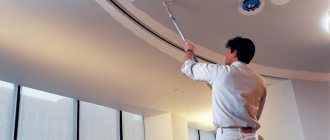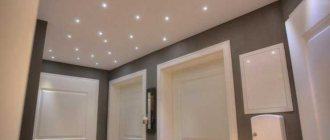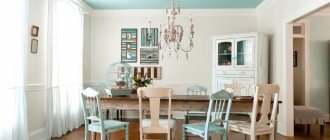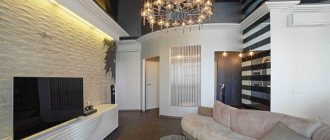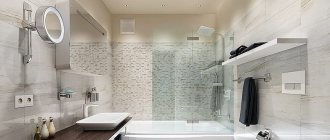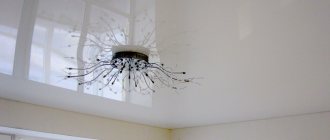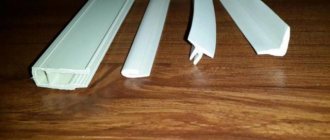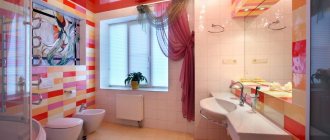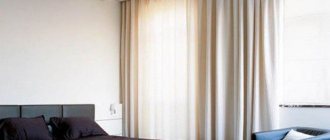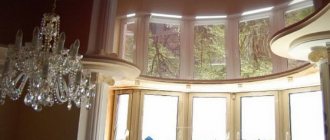Ceiling design today allows you to implement a wide variety of ceiling design options, starting with the simplest and most budgetary methods, ending with the construction of stylish suspended structures. Thanks to the emergence of new materials on the market, completely new technologies have begun to be used for finishing the ceiling surface. Painted ceilings are gradually becoming a thing of the past; whitewashed ceiling surfaces have practically sunk into oblivion. Today, suspended and stretch ceilings have come to the fore, models that are distinguished by high technological and aesthetic properties.
Both design options are in demand. The reasons for this popularity are more psychological in nature. Wet finishing work has always been considered the most labor-intensive and dirty work process. A plastered or whitewashed ceiling, although not so expensive, was associated with a considerable amount of work. Finishing work with ceilings included preparation of the ceiling surface and mandatory cleaning of the room, caused by a large amount of dirt and debris. Today, almost nothing remains of suspended structures after installation. All work on the installation of suspended ceilings and tension systems is carried out quickly and, most importantly, dry.
The choice in favor of new technologies is obvious, despite the fact that there are significant differences between suspended ceiling systems and tensioned fabric. Let's consider how both finishing options differ, and which method of decorating ceilings is preferable today.
Criterion 1: price
The cost of the ceiling covering consists of the price per unit of work and the cost of materials used
If we talk about standard ceilings without any frills, then the prices for both stretch and suspended ceilings are quite affordable. A sheet of plasterboard for the ceiling will cost about 300–400 rubles, waterproof sheets are much more expensive - about 1000 rubles apiece. But a slatted suspended ceiling can cost you a pretty penny: from 950 rubles to 3,500 rubles per square meter (Dutch brand Luxalon).
For the installation of suspended ceilings made of PVC (plain matte, glossy or satin), craftsmen will ask from 250 rubles per square meter. By the way, the price for installation services does not consist of the cost of the canvas, but of the cost of the fittings and their quantity used to install the ceiling. That is, the more corners and other obstacles (for example, heating pipes) in your room, the higher the installation cost.
If you decide to make stretch ceilings with a pattern or fabric (for example, DESCOR, Clipso brands), then get ready to shell out 3,000 rubles per square meter.
What is the difference between a suspended ceiling and a suspended ceiling?
It is difficult to choose, especially for a non-specialist, guided only by appearance, without deep knowledge about the quality and features of operation. Both decorative finishing options feature a perfectly flat surface and excellent ceiling geometry. But there are differences, and quite significant ones.
Usually there are two basic design differences:
- Tensile cladding is a continuous panel of fabric or film stretched on a pre-installed aluminum frame;
- The suspension system is made up of separate sections, panels or sheets, fixed to a special frame using cable or tape fastenings that hold the frame and decorative coating in the same plane.
In addition to structural features, there are also significant differences between a suspended ceiling and a suspended ceiling in terms of finishing safety. The canvas or film is always PVC or multilayer fabrics based on it, while hanging decor is aluminum panels, plasterboard, pressed sandwiches made of mineral granules, wood processing products.
Important! This means that in the event of a fire, the polymer ceiling will burn, releasing a huge amount of toxic gases, while a suspension system made from non-flammable and low-flammable materials does not have this drawback.
In some cases, a system of non-combustible slabs can even protect the room and block the spread of flame. And although modern PVC films and membranes have additives that block the spread of fire, mistrust in polymer decorative ceilings still remains.
Performance characteristics
If we compare the suspended and suspended ceiling decor from the point of view of everyday use, the differences look quite significant. The pros and cons of a suspended ceiling and tension system come down to the following:
- The tension polymer system turns out to be too vulnerable to minor mechanical damage and cuts. Therefore, when cleaning or cleaning the surface, very careful handling of detergents and brushes is required. Washing and cleaning a suspended ceiling is much more difficult, since you need to dismantle the panels, wash them and put them back, which takes a lot of effort and time;
- The tension ceiling decor scheme has a huge advantage in terms of preventing water from flowing through the ceiling. The polymer fabric not only withstands flooding, such a ceiling also saves furniture and interior items from getting wet and destroyed. The suspension system in such a situation turns out to be useless; the ceiling not only cannot withstand water, but in some cases, for example, when using drywall, it completely fails.
The negative aspects of a stretch ceiling include the presence of a flapping effect. Every time you open doors or windows, the ceiling film makes a slight noise, like a membrane. Suspended structures do not have such a defect, since the decorative panel lies freely on the frame or is rigidly fixed to the mounting profile.
Appearance and Design
Comparing two ceiling finishes is quite difficult. Both suspended and suspended ceilings, photos, can be very impressive and bright in style and design.
Using polymer sheets in combination with plasterboard box inserts, you can build very complex multi-level compositions. This technology is practically unavailable when using conventional sectional or panel suspended ceilings.
But this does not mean that the latter type of ceiling covering is inferior in decorative properties to film systems. The difference in the decor of stretch and suspended ceilings lies in the approach to organizing ceiling systems. Film or fabric materials are more modern schemes in which you can use printing, graphics, complex-level lighting and even inserts with photographic images.
A suspended ceiling is most often a classic version of flat decor, which can use more traditional materials such as wood, anodized aluminum, painted steel panels. They are comfortable and practical, without creating the impression of excessive pomp and pretentiousness.
Environmental friendliness
The first thing that apartment owners notice after installing a stretch ceiling is the appearance of a smell. Chemical, but not irritating, although not pleasant. In designs from well-known brands, there may be no odor, since the material contains various types of flavors and odorants that mask volatile substances.
In cheap stretch ceilings, the smell can bother you for several weeks, but in the most budget models, the chemicals manifest themselves with every increase in the temperature in the room. In this sense, film and polyester fabrics remain problematic, even if the fabric has received all hygienic permits and safety certificates.
Suspended structures turn out to be safer. Their construction uses metals, gypsum and wood, and in addition, they do not interfere with air movement. While suspended ceilings practically do not allow air to pass through and do not allow water vapor to pass through.
Installation
If we compare ceiling decor in terms of installation costs, then tension structures turn out to be more profitable. The assembly and installation of a film or fabric ceiling takes, on average, half the time and effort than in the case of assembling a supporting frame and installing hangers for a panel, and especially a plasterboard ceiling.
Suspension systems are interesting because the supporting frame and panel cladding can be easily dismantled, removed and returned to the ceiling. For tensile structures, removing the fabric, and especially the film, can be a serious problem. During installation, the material is preheated, stretched, and only then fixed to the frame. If for technological or other reasons it is necessary to remove the film, then putting it back in place will be difficult, although possible.
Important! The exception is single-layer fabric ceilings, for which special lacing is used. In this case, installing a decorative covering is no more difficult than in the case of dismantling a suspended structure.
Care
Suspended ceiling systems turn out to be quite unpretentious in everyday life. On average, cleaning the ceiling takes no more than two hours a month. Designs with glossy panels have to be washed and cleaned somewhat more often. Suspension systems with matte panels are very popular in offices, public places and even in production, in any conditions where there is a lot of dust due to constant contact with the street.
On stretch ceilings, any, even the smallest, dirt becomes clearly visible within a week after cleaning the room. But there is also an advantage - due to the fact that the film or fabric base is one single panel, the cleaning process is easier, since there are no external frame elements that interfere with the movement of the brush and sponge.
Life time
It is quite difficult to compare how long these two completely different types of ceiling decor can last. Despite the fact that most manufacturers provide a guarantee for suspended ceilings for up to 15 years, in reality the service life in each specific case depends on the conditions:
- Correct installation of the frame and film material;
- Quality of tension decor;
- Proper care of ceiling finishes.
It is clear that a maximum period of 15-20 years is possible only under ideal conditions. In reality, frequent temperature changes, exposure to frost, excessive use of detergents and cleaning products, removal and installation of material, all this leads to a significant reduction in resource.
Important! In practice, a suspended ceiling with good care can last up to 15 years. After this period, degradation of the polyvinyl chloride fabric begins, and sometimes sagging is observed due to the stretching material. Sometimes holes just appear at the sites of cuts and damage.
Suspended structures in this sense are more reliable; they are easy to repair and maintain. If necessary, you can replace part of a section of slab or even a single piece of drywall panel. The service life of the suspension, if installed correctly, reaches 30 years, so investing in suspended ceiling systems looks more attractive.
Which ceiling is cheaper, suspended or suspended?
The price of film and fabric ceiling systems largely depends on the design, texture and decoration of the decor. For example, PVC, no matter whether in satin or gloss, costs, taking into account the frame details and installation work on the four corners, at the level of 8-10 dollars per m2. Stretch options with photo printing will cost from $15 per square. The most expensive fabric stretch ceilings are estimated at $30 per square meter, but exclusive designer options can cost two to three times more.
The simplest suspended ceiling structures with installation will cost 2 times more than tension ones, although the costs of materials, profiles and fittings themselves are estimated at approximately the same level as the costs of purchasing the fabric and profile of the tension system. The most modern models of Armstrong or facet ceilings, again with installation, will cost an average of at least $50 per square.
Criterion 2: installation features
Installation of suspended plasterboard ceilings
Installing suspended ceilings is a much faster and cleaner process. It is quite difficult to litter when installing a tension structure: a heat gun is used here (if we talk about PVC ceilings). The entire process from measuring, attaching baguettes, installing lighting wiring to installing the canvas takes approximately three to six hours.
The installation of suspended plasterboard ceilings cannot be done without dust and construction debris. And the installation process itself will take from two to ten days, depending on the complexity of the design.
Film width and color for matte stretch ceilings
The main colors of matte canvases have a width of 5.5 meters. This makes it possible to install them in various rooms. The following colors are popular: white, yellow, beige, blue, pink, purple. The width of the film in less popular shades is 3.5 meters. Specific colors are produced in widths of 2.2 and 1.4 meters. This is due to low demand.
Criterion 4: Maintain cleanliness
Caring for suspended and stretch ceilings is not at all difficult
It is easier to care for PVC ceilings. During cleaning, it is enough to wipe them with a soft damp cloth, and remove heavy dirt with a mild detergent. With fabric stretch ceilings it is more difficult. It is possible to remove the stain from them, but a lint will form on the canvas, which will be noticeable under a certain lighting angle.
Suspended ceilings are easy to maintain. But plasterboard ceilings will have to be painted periodically to update the color. You need to wipe off dust from such ceilings with an almost dry soft cloth.
In what cases and premises which is best suited?
Satin on the ceiling:
- suitable for any design style, be it classic or modern;
- best emphasizes the curved shapes of the ceiling;
- gives the room sophistication and respectability;
- in the bedroom and nursery creates a feeling of calm and comfort;
- the living room is relaxing and peaceful.
Bathrooms, kitchens, corridors, and toilets are well suited for matte film. Fabric fabric looks great in the living room and nursery under certain types of lighting. If we take into account the strength, then for active children in the nursery there is no equivalent substitute for matte polyester.
Criterion 6: fire resistance and moisture resistance
Neighbors flooded: only suspended ceiling can withstand
Both drywall and tensile construction are fire resistant. But PVC and fabric ceilings emit toxic substances when heated. In this regard, a suspended ceiling is safer, but during a fire it can simply collapse.
As for moisture resistance, the undisputed leader here is the PVC stretch ceiling. If your neighbors flooded you, then most likely the ceiling will withstand this test. The coating can hold up to 100 liters per square meter. Then this water can be drained by calling a specialist.
An indelible stain will remain on fabric ceilings after a flood: such ceilings will have to be replaced.
But drywall will not withstand contact with water. The drywall will be saturated with moisture, which will travel further. Mineral fiber and metal slats also do not like water.
What is a satin ceiling
When you hear the word satin, you immediately associate it with thick cotton bedding. And only a few know that the name of the fabric is not based on the type of fiber, but on the unusual way of weaving the threads. What does this have to do with satin ceilings? The most direct: on the front side of the polyvinyl chloride film (PVC) using special equipment, the complex weaving of fibers inherent in the satin weaving method is imitated using embossing.
It turns out that in terms of their technical characteristics, PVC satin and PVC with a matte surface are absolutely identical. The higher price of satin fabric is explained by the additional technological operation of applying embossing.
Criterion 7: Durability
Many manufacturers write that stretch ceilings will last up to 20 years. However, this figure is far from the truth. Experts who install the coating claim that after five to seven years, the canvas loses its elasticity and moisture resistance, and the ceiling itself begins to become covered with wrinkles.
Suspended ceilings made of plasterboard are more durable - their service life is up to ten years. But during this time, you will have to carry out cosmetic repairs more than once to update the color and hide small cracks and scuffs.
I am for suspended ceilings!
They are often made from natural materials. And it is important for a person to be surrounded by natural decoration. Suspended ceilings are more solid and durable. Oleg Kazhushkin Expert in the field of architecture and construction kjland.ru
Which ceiling will last longer?
If you want to get attractive information that ceilings can be almost eternal, you better read the manufacturers’ advertising website. This applies to both types of coverage.
In reality, everything is not as rosy as they try to convince us.
According to official assurances, stretch ceilings last up to 20 years. However, it is not. Even the highest quality coating begins to lose its properties after an average of 5-7 years. Elasticity, moisture resistance, smooth fabric without wrinkles... As soon as a certain period passes, you can forget about it.
The period may be longer, it all depends on the operating conditions. But we still don’t recommend counting on a couple of decades without repairs.
With drywall, everything is not so simple. On the one hand, a suspended ceiling can actually withstand up to 10 years of service. On the other hand, there is a possibility that you will have to renew the coating much earlier - minor scuffs, faded paint, cracks at the joints... But all this is not a full-scale repair, which threatens you in the first case.
Criterion 8: Design variety
Suede ceiling in a studio apartment
Stretch ceilings are represented by a large number of design solutions. You can order both laconic PVC ceilings (single-color and multi-colored matte, satin, glossy), and choose a coating with a texture like leather, velvet, marble, suede and photo printing.
Ceiling with Double Vision effect
In addition, in apartments with low ceilings, the effect of large space can be achieved using Double Vision ceilings (for example, from the brands MSD, PONGS). When the backlight is turned on, additional images appear on such coatings.
Soaring and carved stretch ceilings (Beltendo, Apply) look interesting.
Carved stretch ceiling
As for suspended ceilings, they are not inferior to suspended ceilings in design. With just one plasterboard you can make incredibly beautiful multi-level ceilings, decorate them with paint, ceiling tiles or textured wallpaper.
Slatted suspended ceiling
Modular stretch ceilings have long gone out of fashion, but they have been replaced by very stylish options - grilyato with a structure in the form of a volumetric mesh (for example, the Cesal brand), slatted ceilings (Geipel, Luxalon), mirrored cassette and mesh ceilings (Lumsvet, "Albes")
Suspended ceiling
Which ceilings have more design options?
Another important aspect is the variety of design elements. Of course, you want the apartment to be pleasing to the eye. You can see more successful examples of design in our thematic photo collections - we are sure there will be a lot of interesting things there.
Stretch ceilings have a huge number of variations. Different textures (glossy, matte, satin, velvet, translucent...), a wide range of colors, photo printing, hidden LED lighting, vinyl stickers... And the range of decorations is not limited to this - they are truly almost unlimited.
Almost the same thing is said about suspended ceilings. Except, perhaps, for the variety of textures. However, multi-level hanging structures with carved decorative slabs look simply stunning. In addition, to give them originality, they use wallpaper, a variety of paints, and all kinds of inserts.
Interior design options
Even with a small number of colors, there is still a lot of room for modeling the ceiling structure. There are options in which matte stretch ceilings are located only on one level, and the second part of the structure is plasterboard, as in the next photo.
The most popular remain one and two-level matte stretch ceilings, as in the photo presented below.
And the second level does not have to be exactly tension. You can use any materials to construct your ceiling, combining several types of finishes. You can combine non-shiny and glossy textures to create three-dimensional compositions. There are a lot of execution options.
The classic flat version with side lighting around the perimeter is the most popular option for a not too expensive finish. This solution will fit very harmoniously into most interiors. The color of the backlight can often be changed using the remote control.
Matte surfaces will always be a classic in design. But such a solution does not necessarily have to be present only in traditional interiors. It can be successfully used in modern houses with appropriate design.
Features of lighting in rooms with matte stretch ceilings
Rules for installing lighting devices:
- in lighting fixtures, the power of incandescent lamps should not exceed 60 W; halogen lamps – 35 W;
- The lampshade or reflector must be located at a distance of at least 250 mm from the canvas (if the reflector is not provided for in the ceiling design, the light source must be no closer than 400 mm to the canvas);
- so that glare from sources is not noticeable on the ceiling, the light must be directed downward;
- dish-shaped chandeliers are equipped with reflectors;
- LED strip is used when installing decorative lighting around the perimeter;
- the use of special protective plastic rings of the required diameter when installing spotlights;
- To avoid overheating, the chandelier blades are mounted on maximally elongated pendants.
